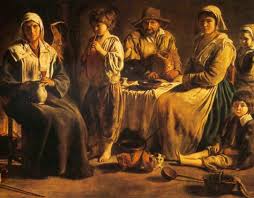“Contextualizing 18th-Century States” Everything You Need to Know
Imagine a world where powerful monarchies, emerging republics, and intricate bureaucracies coexisted—a landscape where the structures of government were in flux and ideas of sovereignty, citizenship, and state power were being redefined. Did you know that the late 1700s witnessed the transformation of political authority across Europe and the Americas, setting the stage for modern nation-states? In this comprehensive guide, we delve into Contextualizing 18th-Century States to explore how states were organized, how they evolved, and how historical forces shaped their identities. Whether you are a student of history, a political science enthusiast, or simply curious about the evolution of governance, this article will provide you with a deep understanding of 18th-century statecraft and its lasting legacy.
Introduction: Navigating a Transformative Era
The 18th century was a period of radical change—a time when old feudal orders were being challenged and new forms of government emerged. In this era, states were not static entities; they were dynamic constructs shaped by wars, revolutions, intellectual movements, and economic transformations. The process of Contextualizing 18th-Century States involves examining how these diverse political entities adapted to internal pressures and external challenges, ultimately paving the way for the modern state system.
A Captivating Hook
Imagine living in a time when the very idea of what a state should be was hotly debated. Could a monarchy be reformed from within? Were republican ideals viable alternatives to centuries-old dynastic rule? How did economic pressures and Enlightenment ideas influence political organization? These questions formed the backbone of debates in the 18th century—a debate that continues to inform our understanding of governance today.
What This Article Will Cover
In this in-depth post, we will:
- Define “Contextualizing 18th-Century States”: Provide a clear explanation of what this concept entails and the essential characteristics that define 18th-century state structures.
- Explore Historical and Contextual Background: Trace the origins and evolution of state formations during the 18th century, highlighting key milestones and events that reshaped political authority.
- Examine In-Depth Themes: Break down major aspects such as centralized versus decentralized power, the role of Enlightenment ideas, economic influences, and the impact of revolutions.
- Discuss Importance and Benefits: Explain why understanding the context of 18th-century states is crucial for comprehending modern political systems, economic policies, and cultural identities.
- Address Common Misconceptions and FAQs: Clarify prevalent myths and answer common questions about the nature and evolution of states in the 18th century.
- Review Modern Relevance and Current Trends: Explore how the legacy of 18th-century statecraft continues to influence contemporary governance, policy debates, and global affairs.
- Conclude with Key Takeaways and a Call-to-Action: Summarize the core insights and encourage further exploration and discussion.
By the end of this exploration, you will have a nuanced understanding of Contextualizing 18th-Century States and appreciate how historical dynamics from this transformative period continue to shape our world.
What Are “Contextualizing 18th-Century States”? A Clear Definition
Defining the Concept
Contextualizing 18th-Century States refers to the process of understanding and interpreting the political, social, and economic structures of states during the 1700s within their historical context. This involves examining how states were organized, the ideologies that influenced governance, and the external pressures that forced these states to evolve. It is about placing the political institutions of the time—whether absolute monarchies, constitutional frameworks, or emerging republics—within the broader tapestry of 18th-century society.
Essential Characteristics
Dynamic State Formation:
States in the 18th century were in constant flux. Traditional feudal structures were giving way to more centralized bureaucracies, and ideas of national identity were beginning to take shape.Influence of Enlightenment Ideals:
Enlightenment thought profoundly impacted the political discourse of the time. Concepts such as natural rights, separation of powers, and popular sovereignty began to challenge the legitimacy of inherited rule.Economic Transformation:
Shifts in trade, agriculture, and early industrialization had significant implications for state power. Economic pressures often drove political reforms and even revolutions.Social Stratification and Citizenship:
The relationship between the state and its citizens was evolving. New social classes emerged, and debates over rights, representation, and the distribution of power became central to political life.International Relations:
The 18th century also saw states engaging in extensive diplomacy, warfare, and colonial expansion. These external interactions further influenced domestic political structures and policies.
Historical and Contextual Background
The Pre-Modern Landscape: From Feudalism to Early Modern States
Before the 18th century, Europe was predominantly organized under feudal systems with decentralized power, where loyalties were tied to local lords rather than a central authority. However, several transformative processes set the stage for modern state formation.
The Legacy of the Renaissance and Reformation
Rediscovery of Classical Antiquity:
The Renaissance revived the ideas of ancient Greece and Rome, encouraging a reevaluation of governance and citizenship. This intellectual revival laid the groundwork for later political innovations.Religious Upheaval:
The Reformation challenged the unchallenged authority of the Catholic Church, contributing to the fragmentation of religious unity and prompting states to assert their own authority.
The Influence of the Scientific and Enlightenment Revolutions
Rational Inquiry and Empiricism:
The Scientific Revolution brought a new focus on observation, experimentation, and logic, which spilled over into political thought. Enlightenment philosophers built on these ideas to question traditional forms of authority.Political Philosophy and Ideology:
Thinkers like John Locke, Montesquieu, and Rousseau introduced ideas about natural rights, the social contract, and the separation of powers. Their writings laid the ideological foundation for modern democratic states.
Early Economic and Social Changes
Mercantilism and Early Capitalism:
The 17th and 18th centuries witnessed the rise of mercantilism and the beginnings of capitalist economies. This economic transformation created new social classes and shifted power dynamics, influencing state policies and administrative reforms.Urbanization and Demographic Shifts:
As populations began to concentrate in growing urban centers, states had to adapt to new challenges related to public order, taxation, and infrastructure development.
Notable Historical Anecdotes
The Glorious Revolution (1688):
This event in England marked a critical turning point by establishing parliamentary sovereignty over the monarchy. It served as a precursor to many of the democratic principles that would be fully realized in the 18th century.The American and French Revolutions:
These revolutionary movements not only exemplified the application of Enlightenment ideals but also forced a reexamination of what a state should be. The political experiments of these revolutions provided powerful case studies in state formation and reform.
In-Depth Exploration: Key Themes in Contextualizing 18th-Century States
To fully appreciate Contextualizing 18th-Century States, it is necessary to delve into several key themes that defined the political landscape of the era.
1. Political Structures and Governance
The Evolution from Absolutism to Constitutionalism
Absolute Monarchies:
Many states in the early 18th century were ruled by absolute monarchs who claimed divine right. These rulers wielded centralized power, but their authority was increasingly challenged by emerging ideas of accountability.The Rise of Constitutional Frameworks:
In response to growing demands for representation and rights, constitutional models began to take shape. The English Bill of Rights (1689) and the subsequent evolution of parliamentary government set important precedents for limiting royal power and enhancing citizen participation.
Administrative Reforms and Bureaucracy
Centralization of Power:
As states sought to strengthen their control, many embarked on projects of administrative reform. The creation of professional bureaucracies, standardized legal codes, and efficient tax systems were central to these efforts.Case Study: Prussia’s Reforms under Frederick the Great:
Frederick the Great of Prussia is celebrated for his efforts to modernize state administration. His reforms in education, law, and military organization exemplify how enlightened rulers attempted to combine absolute power with rational, bureaucratic efficiency.
2. Economic Foundations and State Power
Mercantilism and the Emergence of Capitalism
State Intervention in the Economy:
Mercantilist policies, which emphasized the accumulation of wealth through trade surpluses and colonial expansion, were a hallmark of 18th-century states. These policies required strong state apparatuses to regulate commerce and secure national interests.Transition to Early Capitalism:
By the late 18th century, shifts toward more market-oriented economies began to undermine traditional mercantilist practices. This transition paved the way for modern economic policies and created new pressures on state governance.
Fiscal Challenges and Reforms
Taxation and Public Finance:
The ability of a state to raise revenue through taxation was crucial for maintaining power and funding public services. Inefficiencies and inequities in tax collection often led to fiscal crises, which in turn spurred political unrest and calls for reform.Economic Crises as Catalysts for Change:
Repeated fiscal shortfalls and economic downturns highlighted the need for state reform. The economic pressures of the late 18th century were instrumental in driving revolutionary change, as seen in the French Revolution’s radical reorganization of economic and social structures.
3. Social Dynamics and Citizen Identity
The Transformation of Citizenship
Emergence of a New Middle Class:
Economic transformations led to the rise of the bourgeoisie—a middle class that increasingly demanded political representation and social equality. This shift challenged the old aristocratic order and forced states to redefine citizenship.Rights and Representation:
The ideas of natural rights and the social contract began to take hold, transforming how citizens viewed their relationship with the state. Documents like the American Declaration of Independence and the French Declaration of the Rights of Man articulated these new ideals, laying the groundwork for modern democratic citizenship.
Cultural and Ideological Shifts
Public Sphere and Political Debate:
The growth of print culture, coffeehouses, and salons created spaces where citizens could exchange ideas and challenge authority. This public sphere was instrumental in fostering a sense of collective identity and mobilizing support for political reform.Educational Reforms and Enlightenment Ideals:
Enlightenment principles not only influenced political structures but also transformed educational practices. As states invested in public education and literacy, citizens became more informed and engaged, further strengthening demands for political accountability.
4. International Relations and Global Context
Diplomatic Maneuvering and Warfare
Balance of Power:
The late 18th century was a period of intense diplomatic activity, as states sought to maintain a balance of power in Europe and beyond. Alliances, treaties, and wars were all part of the intricate dance of international politics.Colonial Expansion:
The economic and military power of 18th-century states was closely linked to their colonial ambitions. The competition for colonies not only enriched states but also fueled conflicts that had far-reaching global implications.
Case Study: The American Revolution’s International Impact
- Transatlantic Dynamics:
The American Revolution was not an isolated event; it had profound effects on European politics and colonial policies. The success of the revolution challenged the old order and inspired similar movements in other parts of the world, illustrating the interconnectedness of state formation and global politics.
Importance, Applications, and Benefits
Understanding Contextualizing 18th-Century States is crucial for a variety of reasons, ranging from historical insight to practical applications in modern governance and society.
Shaping Modern Governance and Political Systems
Foundations of Democracy:
Many modern democratic institutions trace their origins to the reforms and ideological debates of the 18th century. Understanding this history helps explain the evolution of rights, representation, and constitutional governance.Policy Development:
Lessons from the fiscal crises and administrative reforms of 18th-century states inform modern public policy. Governments today can learn from historical examples to design more equitable and efficient systems.
Economic and Social Insights
Economic Policy:
The transition from mercantilism to early capitalism offers valuable lessons on state intervention and market regulation. Studying these shifts can help contemporary economists and policymakers address issues like income inequality and fiscal sustainability.Social Reform:
The redefinition of citizenship and the rise of the middle class in the 18th century provide a blueprint for addressing social injustice and promoting civic engagement in modern societies.
Educational and Cultural Enrichment
Interdisciplinary Learning:
Exploring the political, economic, and social dimensions of 18th-century states encourages a holistic understanding of history. This interdisciplinary approach enriches education and fosters critical thinking.Cultural Literacy:
Knowledge of the historical evolution of states deepens our understanding of national identity, cultural heritage, and global interconnectedness—an understanding that is essential for informed citizenship in a diverse world.
Practical Benefits for Modern Organizations
Corporate Governance:
Modern businesses can draw parallels between state reforms and organizational change. Principles such as transparency, accountability, and the distribution of power are as relevant in corporate settings as they are in public governance.Innovation and Adaptability:
The dynamic evolution of 18th-century states underscores the importance of adaptability in the face of crisis. Organizations and institutions that embrace change and innovate in response to challenges are better positioned to thrive in today’s volatile environment.
Addressing Common Misconceptions and FAQs
Despite extensive scholarship on the subject, several misconceptions about Contextualizing 18th-Century States persist. Below, we address some common misunderstandings and answer frequently asked questions.
Common Misconceptions
Misconception 1: “18th-century states were static and unchanging.”
Clarification:
Far from being static, 18th-century states were dynamic and continually evolving in response to economic pressures, social changes, and political ideologies.Misconception 2: “The Enlightenment only affected political theory, not state organization.”
Clarification:
Enlightenment ideas fundamentally reshaped the organization of states, influencing everything from administrative reforms to the definition of citizenship and the structure of government.Misconception 3: “Modern states have little to learn from 18th-century models.”
Clarification:
Many principles developed during the 18th century—such as constitutionalism, separation of powers, and fiscal responsibility—remain central to modern governance. Historical insights continue to inform contemporary debates and policy-making.
Frequently Asked Questions
Q1: What does “Contextualizing 18th-Century States” involve?
A: It involves examining the political, economic, and social structures of states in the 18th century within their historical context, understanding the forces that shaped their evolution, and analyzing how these models influenced modern governance.
Q2: How did Enlightenment ideas impact state organization in the 18th century?
A: Enlightenment ideals promoted the use of reason, the protection of individual rights, and the idea of popular sovereignty. These concepts led to reforms in state administration, the development of constitutional frameworks, and the redefinition of citizenship.
Q3: Why is it important to study the evolution of 18th-century states?
A: Understanding how states evolved during this period provides insight into the origins of modern political institutions, economic policies, and social structures. This knowledge can inform current governance practices and promote more effective public policy.
Q4: Can lessons from 18th-century state formation be applied to modern challenges?
A: Absolutely. The challenges of fiscal management, administrative reform, and social integration that 18th-century states faced are echoed in today’s globalized world. Historical lessons help modern policymakers design better systems for addressing these issues.
Modern Relevance and Current Trends
Although Contextualizing 18th-Century States is rooted in history, its relevance persists in today’s political and social landscape. Let’s explore some current trends and developments that highlight its enduring impact.
Digital Governance and Transparency
E-Government Initiatives:
Modern states increasingly use digital platforms to promote transparency, citizen engagement, and efficient public services. These initiatives reflect the Enlightenment ideals of accountability and rational administration that emerged in the 18th century.Data-Driven Policy:
Today’s governments rely on big data and analytics to inform policy decisions—a modern extension of the systematic, evidence-based approaches pioneered by early modern states.
Globalization and Comparative Politics
Interstate Comparisons:
Comparative studies of state formation across different regions reveal that many of the challenges and reforms of 18th-century states continue to be relevant. Issues such as federalism, centralization, and the balance between regional autonomy and national unity remain central to political debates worldwide.International Institutions:
The evolution of state structures in the 18th century laid the groundwork for the development of modern international organizations. The principles of sovereignty, rule of law, and cooperative governance continue to underpin global institutions like the United Nations and the European Union.
Educational and Cultural Initiatives
Interdisciplinary Programs:
Universities are increasingly offering interdisciplinary courses that examine the history of state formation, integrating perspectives from political science, economics, sociology, and cultural studies. These programs equip students with a holistic understanding of how historical processes shape modern governance.Public History Projects:
Museums, digital archives, and public lectures make the history of 18th-century states accessible to a broader audience, fostering an informed citizenry that appreciates the complexities of state evolution.
Ongoing Scholarly Debates
Revisiting Revolutionary Legacies:
Modern historians continue to debate the causes and consequences of the political revolutions of the 18th century. New research is uncovering nuanced interpretations of state formation, class dynamics, and the impact of Enlightenment ideas on political institutions.Global Perspectives on State Formation:
There is a growing trend to include non-European perspectives in the study of state formation. This approach broadens our understanding of how diverse cultures have contributed to the development of modern statecraft.
Conclusion: The Enduring Importance of Contextualizing 18th-Century States
Our exploration of Contextualizing 18th-Century States has revealed a period of profound transformation—a time when the foundations of modern governance were laid through a dynamic interplay of political innovation, economic pressures, and social change. By examining the evolution of state structures during this era, we gain valuable insights into the origins of contemporary political systems and the enduring principles that continue to shape our world.
Key Takeaways
Dynamic Evolution:
18th-century states were not monolithic; they evolved in response to internal reforms and external challenges, paving the way for modern concepts of democracy, citizenship, and governance.Enlightenment Influence:
The intellectual legacy of the Enlightenment played a pivotal role in reshaping state structures, emphasizing reason, transparency, and the protection of individual rights.Economic and Social Drivers:
Economic transformations and social pressures, including urbanization and the rise of new social classes, were central to the evolution of state power and organization.Modern Relevance:
The principles and challenges of 18th-century state formation remain highly relevant today, informing modern governance, policy-making, and our understanding of global political dynamics.
Call-to-Action
Keep Exploring:
Dive deeper into the fascinating history of state formation by reading further, visiting historical sites and museums, or enrolling in courses on political history and governance.Engage with the Community:
Share your thoughts and questions in the comments below. Join online forums or local discussion groups that explore the evolution of political institutions and their modern implications.Apply the Lessons:
Whether you’re a policymaker, a student, or an engaged citizen, let the insights from 18th-century state formation guide your understanding of modern governance. Advocate for transparent, accountable, and inclusive political systems that honor the lessons of the past.
By embracing the study of Contextualizing 18th-Century States, we not only honor our historical legacy but also empower ourselves to build more resilient and equitable societies today.
Final Reflections
The evolution of 18th-century states is a testament to the transformative power of ideas and the enduring impact of historical change. From the reformation of absolute monarchies to the birth of democratic institutions, the late 18th century remains a critical chapter in the story of human governance. As we navigate the complexities of the modern world, the lessons gleaned from this era continue to inform our approaches to political, economic, and social challenges. Understanding how states emerged, evolved, and responded to crises in the 18th century not only enriches our historical perspective but also provides practical insights for shaping the future.
Thank you for joining us on this comprehensive exploration of Contextualizing 18th-Century States. We invite you to subscribe for more insightful content, leave your comments below, and share this post with anyone interested in the fascinating dynamics of state formation and historical transformation.







